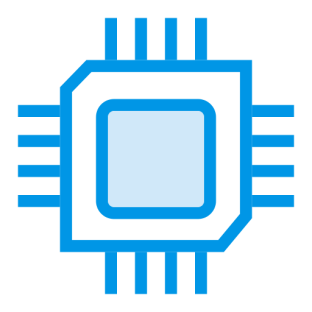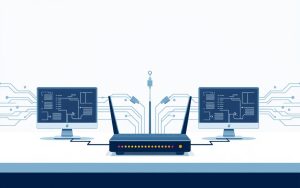A data network is vital digital infrastructure for seamless communication between devices. It’s a sophisticated system that transfers information using advanced switching technologies and transmission lines. This network connects multiple access points efficiently.
Computer networks have come a long way since ARPANET in the late 1960s. They’ve evolved from simple two-device connections to the complex global internet we use today. These networks now form the backbone of modern digital communication.
Networks vary in scale and complexity. They can link just two devices or span continents, supporting billions of connections. Bandwidth measures network capacity, determining the maximum data transfer speed through devices.
Modern networks use various communication standards. Ethernet is common for wired connections, while 802.11 is used for wireless local area networks. These technologies enable diverse communication architectures to support different needs.
Data networks are crucial in our interconnected world. They drive business, education, entertainment, and global connectivity. From personal devices to cloud infrastructures, networks revolutionize how we share and process information.
Understanding Data Networks: Core Concepts and Fundamentals
Data networks are the backbone of modern digital communication. They connect devices and enable seamless information exchange across global platforms. These network components work together to transmit data efficiently and reliably.
Networks use complex architecture to facilitate data transmission processes. Communication technologies have changed how information travels between devices and systems.
Basic Components of Data Networks
Data networks include several essential elements for smooth communication:
- Nodes (computers, servers, smartphones)
- Network interface cards (NICs)
- Switches and routers
- Transmission media (cables, wireless signals)
How Data Networks Function
Modern data networks use advanced communication protocols to manage data routing and transmission. These systems ensure efficient data flow across various network types.
From local area networks to global internet connections, data moves seamlessly through these protocols.
Data Transmission Methods
Data networks use multiple techniques to move information:
| Transmission Method | Characteristics |
|---|---|
| Circuit Switching | Dedicated communication channel |
| Packet Switching | Data divided into smaller packets |
| Message Switching | Complete message routed between nodes |
Understanding these network basics helps organizations design robust communication systems. These infrastructures support modern digital interactions and keep information flowing smoothly.
What Is Data Network in Computer: A Comprehensive Overview

Data networks are crucial for modern computing. They allow digital devices to communicate seamlessly. These systems help computers, smartphones, and servers exchange information quickly and efficiently.
Data communication has evolved remarkably since 1969. ARPANET started with just four nodes using 50 kbit/s circuits. Today, we have a complex global internet infrastructure.
Computer network types have changed how we share and process information. They’ve transformed our digital landscape in incredible ways.
Key Components of Data Networks
- Transmission media (coaxial cables, optical fibers)
- Network devices (routers, switches)
- Communication protocols
- Data transmission methods
Modern network protocols like TCP/IP have revolutionized data communication. They’ve enabled unprecedented connectivity across the globe. Transmission speeds have improved impressively over the years.
| Year | Ethernet Speed | Technology Milestone |
|---|---|---|
| 1980 | 2.94 Mbit/s | Initial commercial speeds |
| 1995 | 100 Mbit/s | Significant speed improvement |
| 2018 | 400 Gbit/s | Cutting-edge transmission rates |
Various computer network types serve different purposes. Local Area Networks (LANs) connect devices within a small area. Wide Area Networks (WANs) facilitate long-distance communication.
Each network type plays a vital role in our modern digital infrastructure. They shape how we connect and communicate in today’s tech-driven world.
Types of Data Networks and Their Applications
Data networks are vital for modern digital communication. They connect devices and enable smooth information exchange. These networks come in various types, each serving unique purposes.
Networks are grouped by geographical coverage and specific uses. Let’s explore the main types of networks and their applications.
Local Area Networks (LAN)
LANs connect devices in small areas like offices or homes. They use Ethernet or Wi-Fi for fast, secure data transfer. LANs are great for linking computers, printers, and other devices.
- Ideal for small-scale network applications
- High-speed data transfer
- Low latency communication
Wide Area Networks (WAN)
WANs cover large areas, linking multiple LANs across cities or countries. The Internet is the largest WAN, connecting billions of devices worldwide.
Metropolitan Area Networks (MAN)
MANs fill the gap between LANs and WANs. They typically cover a city or large campus. These networks provide fast connectivity for organizations with multiple local sites.
Personal Area Networks (PAN)
PANs connect devices in a person’s workspace. They use Bluetooth or wireless USB for short-range connections. These networks are perfect for linking personal electronic devices.
| Network Type | Coverage Area | Primary Use |
|---|---|---|
| LAN | Single building/campus | Local device connectivity |
| WAN | Global/Continental | Long-distance communication |
| MAN | City/Metropolitan | Regional network integration |
| PAN | Personal workspace | Device interconnection |
Each network type is crucial for today’s digital world. They support everything from personal devices to global business systems. Understanding these networks helps optimize communication infrastructure.
Network Architecture and Communication Protocols
Data networks use advanced protocols to transfer information efficiently. TCP/IP is the main architecture for internet communications. It defines how data packets move across network layers.
The TCP/IP model has four key network layers for smooth data transmission. These layers work together to ensure data reaches its destination correctly.
- Network Access Layer: Handles physical network connections
- Internet Layer: Manages packet routing and addressing
- Transport Layer: Ensures reliable data packet delivery
- Application Layer: Supports end-user communication protocols
The OSI model offers a more detailed seven-layer framework. It provides deeper insights into network communication processes. This model complements the TCP/IP approach.
| Protocol | Primary Function | Layer |
|---|---|---|
| HTTP | Web page transmission | Application Layer |
| FTP | File transfer | Application Layer |
| SMTP | Email communication | Application Layer |
Data packets are the basic units of network communication. These small info chunks travel through network layers. They take the most efficient routes for fast and accurate transmission.
Benefits and Applications of Data Networks in Modern Computing
Data networks have changed how we communicate and use technology. They provide crucial infrastructure for modern computing. These systems enable unmatched collaboration and efficiency levels.
Data networks drive innovation and connectivity in today’s digital world. They integrate cloud computing and IoT technologies. Networks have become vital tools for organizations seeking competitive edges.
Resource Sharing and Collaboration
Networks excel at resource sharing. Organizations can now do amazing things with them.
- Share computing resources across multiple devices
- Enable real-time collaborative work environments
- Access centralized storage systems
- Utilize shared software applications
Cost Efficiency and Scalability
Modern data networks offer great cost-efficiency through scalable infrastructure. Businesses can grow their tech capabilities without spending too much more.
| Network Type | Scalability | Cost Efficiency |
|---|---|---|
| Local Area Network | High | Moderate |
| Wide Area Network | Very High | Low |
| Cloud Network | Extremely High | High |
Enhanced Communication Capabilities
Data networks have changed how we communicate. They support many useful tools.
- Video conferencing
- Instant messaging
- Global collaboration platforms
- Secure remote access
“Networks are the nervous system of modern digital infrastructure, connecting people and technologies across global landscapes.” – Network Technology Expert
IoT and cloud computing keep expanding network capabilities. They create smarter, more responsive tech ecosystems. Over 90% of companies now use cloud solutions. The future of networking looks more connected and dynamic.
Conclusion
Data networks have transformed modern communication. They’ve changed how we connect and share information globally. These systems enable seamless data transfer across vast networks.
The future of data networks promises exciting technological developments. These innovations will reshape our digital landscape. Network security has become a top priority.
Advanced monitoring systems help predict vulnerabilities and failures. 5G and edge computing are expanding network capabilities. They enable faster, more reliable communication across diverse platforms.
Data networks are crucial in connecting people and businesses. They facilitate resource sharing and remote collaboration. These systems allow for instant information exchange.
Ongoing network development drives innovation. It makes our world more interconnected and responsive. The evolution of data networks shows our desire for efficient communication.
Continued investment in new tech and security is vital. We can expect networks to become smarter and more adaptive. They’ll play an even bigger role in our digital ecosystem.







